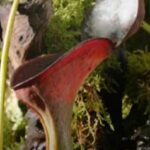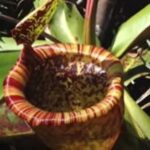As an Amazon Associate, this site earns commissions from qualifying purchases. For more details, click here.
Pitcher plants have become popular among those who want something unique in their garden and plant collection. With their striking appearance and unique way of eating bugs, they can easily become a centerpiece. Ladybugs are among the most common insects so is it safe to let your pitcher plants eat these?
Pitcher plants consume ladybugs and other insects because they have nutrients that nourish these plants Nectar draws insects into the pitcher, where they get trapped and digested.
Why Pitcher Plants Eat Ladybugs
All plants need nitrogen to live. Rich soil contains plenty of nitrogen and other elements which are absorbed by plants through their roots. However, pitcher plants live in bogs, wetlands and swamps where there are very few nutrients in the ground. In fact, pitcher plants cannot survive in fertilized soil.
Because the soil pitcher plants grow in has little to no nutrients, they get it from ladybugs and other insects. Carnivorous plants like nepenthes developed traps specifically to take advantage of what these bugs provide.
To make it clear, pitcher plants consume insects for their nutritional value. All carnivorous plants can create their own food through photosynthesis (which is covered in this guide). Plant food, known as glucose, is used as fuel to power its daily activities, similar to how animals use food.
But glucose alone is not enough to sustain growth. Some pitcher plants can live without eating but only under ideal conditions. Because weather, temperature and humidity can change anytime, plants cannot rely solely on photosynthesis as an energy source.
When pitcher plants digest insects like ladybugs, they also absorb their nutrients. This is similar to a plant that absorbs elements from the soil. Only instead of getting nutrients from the ground, pitcher plants use their traps to extract nutrients from prey.
Aside from bugs, pitcher plants can also eat freeze dried mealworms and fish food. Our favorite is TetraPond Fish Food because it is healthy and well suited for carnivorous plants. Feeding nepenthes freeze dried worms or fish food is also ideal if your plant is in a terrarium.
Nutrients and glucose play similar roles but do not overlap. Think of how food and supplements go hand in hand among humans. The same rule applies to carnivorous plants as they use glucose and nutrients to build roots, leaves, traps, flowers and so on.
One thing pitcher plants cannot handle is nutrition coming from the soil or fertilizer. You cannot grow these plants in fertilized soil because they are used to getting nutrients in their pitchers. This will result in all kinds of problems and could lead to serious health conditions.
How Many Ladybugs Can Pitcher Plants Eat?
If you ask someone how often to feed pitcher plants, you will probably get different answers. That is understandable because the needs of pitcher plants vary.
Many pitcher plants can eat bugs every month or every week. You can also feed them every two weeks. The number of ladybugs the plant can consume will depend on the species.
There is no one single answer because some pitcher plants eat more than others. On one hand you may have a nepenthes that eats just one bug a month. You drop one bug in one pitcher and the plant does fine. You can tell how well a pitcher plant is doing by its color and the presence of liquids in its pitchers.
On the other hand, some nepenthes and sarracenia can eat a few bugs every one or two weeks. While some species are content with one bug, one pitcher a month, other pitcher plants can be fed more. You can feed two or more pitchers every two weeks or so.
The best way to know how many ladybugs your pitcher plant can eat is to check the pitchers. If your plant is indoors, give it one ladybug a month and no other food.
Check back after a few days to see if it has eaten the bug. Next month, feed it every two weeks and so on. If the plant is responding well, you can change things up. Try giving it different types of insects, or feed 2-3 pitchers every month. Or you can drop a few bugs into one or two pitchers biweekly.
If your pitcher plant is outdoors, let it get its own food. Nectar will lure ladybugs and other insects into its traps. There are more than enough choices so you do not have to concern yourself with feeding. For more information you can check out this guide on feeding pitcher plants.
How Pitcher Plants Catch Ladybugs
Because carnivorous plants have the disadvantage of living in poor soil, they adapted to the environment by developing traps. Just like Venus flytraps, pitcher plants use a highly evolved system to lure, catch and eat prey.
Pitcher plants use nectar to get the attention of ladybugs and other prey. This substance is located right on the pitcher, ideal for luring an insect. Once a fly is caught for example, digestive fluids enable the plant to eat it.
There are many types of pitcher plants, but they all secrete nectar, a sweet smelling substance. Insects in the area will notice this and immediately go find the source.
Nectar produces moisture and this is spread in and around the pitchers. Not only is nectar right on the trap, but the moisture makes the pitchers slippery.
When a ladybug gets on the pitcher and tries to eat, the wet surface will cause it to slip into the trap. This is even more likely if it is raining. The hood on some pitcher plants serve a similar purpose. They allow an insect to stand on it but when it rains, they get thrown into the pitcher.
Once a ladybug has dropped into the cupped leaves, it is very difficult to escape. First, liquids prevent the bug from crawling up the pitcher walls. Some pitchers have insect larvae and bacteria which speeds up digestion. Crab spiders reside in some pitcher plants and they help the plant catch more prey and in return, eat some of the food that falls in the trap.
Why is My Pitcher Plant Not Eating?
Thee are many reasons why a pitcher plant may suddenly refuse to eat. If you have a plant that used to eat bugs regularly but has topped suddenly (or slowly), here are some of the likely reasons why.
Infection or Illness
Look for leaves that have turned brown or black. A few of these is fine, but if there are several, it could be a sign of bacterial or fungal infection or other plant diseases.
Does the plant have a foul smell? Do the leaves feel mushy? If there is a bad smell coming from the plant, carefully take it out of the pot. Healthy roots should be firm. If they are mushy, soft and smell bad, root rot has set in. Cut off the rotting roots and repot in a new container with new soil. Water the plant and provide as much light as possible.
Change in Humidity
Mot pitcher plants prefer 50% humidity. They will get by with 40% but anything under 30% and you are risking it.
The problem with low humidity is it causes dryness. Pitcher plants, in particular sarracenia, require plenty of water and moisture. Humidity makes it easier for plants to produce liquids in their pitchers. Without these liquids ,pitcher plants cannot eat.
The simplest way to increase humidity is to water the plant. Water boosts moisture and this helps pitcher plants cope with high temperatures and heat. You can also install a humidifier like the Elechomes SH8830 so you can control its environment even more.
Not Enough Light
All pitcher plants need light to survive. It is essential for photosynthesis and all its other functions. If a carnivorous plant does not receive enough light, it cannot produce traps and will not eat. For the best results, give your plant several hours of light per day. You can use artificial lights if growing nepenthes indoors.
We all want our pitcher plants to grow strong and healthy, so we try and give them the best nutrients possible. But as long as the plant is in a suitable environment, food is not going to be a serious problem. If your plant is outdoors for example, it will have plenty of ladybugs and other insects to feed on.

My fascination with carnivorous plants began many, many years ago with Venus Fly Traps. Now I am more than happy to impart what I know with other enthusiasts and those who are curious about meat eating plants.



